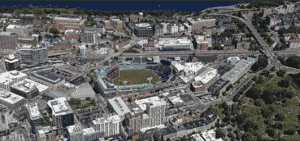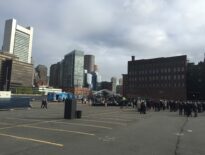
Lab towers, new ground-floor retailers and conversions of aging commercial buildings could render the Fenway neighborhood unrecognizable in coming years.
The last wave of changes in Boston’s Fenway replaced beloved nightclubs and quirky retailers with luxury housing towers.
The next transformation is being driven by life science developers staking claims on the territory between the Longwood Medical Area’s teaching hospitals and Kendall Square’s pharma cluster. Developers expect the next wave of biotech companies to fill approximately 5 million square feet of new life science buildings proposed or under construction in the Fenway.
“It’s the most expensive thing to build, and only certain markets are able to do it,” said developer John Rosenthal, who’s partnering with life science specialist IQHQ on the 940,000-square-foot Fenway Center towers scheduled to begin construction above the Massachusetts Turnpike. “I’ve been saying it for two decades, but it’s coming to fruition.”
About the only neighborhood landmark likely to go untouched is the old Citgo sign. Even Fenway Park is due for a makeover, as a Bruno Mars concert in September debuts the new MGM Music Hall under construction behind the outfield seats.
A who’s-who of major developers – including Alexandria Real Estate Equities, Related Beal, IQHQ and WS Development – are building or proposing large-scale projects potentially bringing tens of thousands of new industry jobs to the neighborhood. And a Boylston Street property approved for a 184-room hotel in 2019 is headed for a change of ownership that could result in plans for more lab space.
Todd Turner, vice president and founder of Spartanburg, South Carolina-based OTO Development, confirmed that his firm no longer controls the 1241 Boylston St. property. According to a source, the half-acre property currently occupied by a service station is under agreement to Alexandria Real Estate Equities, the nation’s largest life science landlord. Alexandria did not respond to a request for comment.
Natural Migration Across the River

A top Alexandria Real Estate Equities executive recently told analysts that the firm views Boston’s Fenway neighborhood as its “next empire to conquer” through acquisitions and development. Photo courtesy of WS Development
A series of high-profile leases since early 2020 firmly established the Fenway’s status as a life science growth cluster.
Samuels & Co.’s 201 Brookline Ave. lab tower attracted leases from venture capital firm Third Rock Ventures and Cambridge-based Tango Therapeutics, while Related Beal’s One Kenmore redevelopment attracted a 75,000-square-foot tenant in Gritstone Bio last fall. Samuels and Alexandria are planning another 550,000-square-foot lab building on a corner of the 401 Park Drive property, which includes the former Landmark Center.
Most recently, venture-backed Cambridge biotech Strand Therapeutics in April committed to over 64,000 square feet at IQHQ’s 20 Overland St., where the developer is planning a new 10-story, 250,000-square-foot lab tower next-door at 109 Brookline Ave.
But Alexandria could be the biggest influence on the neighborhood in the years to come. The Pasadena, California-based REIT owns over 11 million square feet of commercial real estate in Greater Boston, and an executive told analysts this month the firm views the Fenway as its “next empire to conquer” through acquisitions and development.
A Stress Test on Housing and Transportation
The shift toward more commercial development raises new questions about the future of the neighborhood’s housing stock and transportation networks’ ability to handle thousands of new commuters.
“Each developer does individual traffic studies and WS Development has done the biggest and most detailed traffic study around,” said Richard Giordano, director of policy and community planning for the Fenway Community Development Corp. “But none of them take into account game day [at Fenway Park].”
Newton-based WS is partnering with the Boston Red Sox ownership and adjacent property owners the D’Angelo family on the proposed eight-building, 2 million-square-foot, mixed-use redevelopment surrounding the ballpark.
The proposed community benefits include over $25 million in transportation-related projects, including an extension of Richard Ross Way from Van Ness Street to Brookline Avenue. The project would create a new two-way connection between Boylston Street and Brookline Avenue and is designed to ease neighborhood bottlenecks, WS Senior Vice President Yanni Tsipis said.
The developers also are pledging a series of pedestrian and bicycle network improvements, an important consideration in a neighborhood where only a third of residents own a car, according to BPDA research.
Housing advocates have also asked WS to increase the 215-unit residential component of the project, which Tsipis said developers are currently considering. The retail component emphasizes smaller storefronts and a preference for local and independent operators, Tsipis said, although specific square-footage for those categories hasn’t been determined.
“We believe that will help to lend this whole area a real character and soul and create economic opportunities for retail entrepreneurs,” he said.
The scope of the project – spanning four blocks surrounding the ballpark – has some stakeholders worried about sufficient oversight about the design and timing of various buildings. At a recent citizen advisory committee meeting, District 8 City Councilor Kenzie Bok said members should be allowed to review specific building designs.
“If not now, when?” Bok asked. “If you guys walk away with approvals, we don’t necessarily control the order of operations, which is why the public benefits are important.”
More Redevelopment and Conversion Potential
The Fenway’s inventory of class B office and industrial buildings are fertile grounds for additional lab conversions and redevelopments, noted Mike Lee, life science lead for workplace strategy at brokerage Newmark. Heavy masonry construction isolates vibrations, the key to uses involving microscopy or vivariums, and many of the buildings contain deep floor plates to support extensive rooftop mechanical equipment, and heavy floor loads to for lab modules.
“If there’s anything like that, it’s an ideal candidate for repositioning,” Lee said. “The fact that it’s close to Cambridge also helps, and a natural progression into the secondary and tertiary markets.”
Life science developers have relied in recent years on small- and mid-sized leases by early-stage life science companies that expand shortly after receiving infusions of venture capital. But the recent financial market turmoil could affect smaller biotechs the hardest, and erase the imbalance between demand and supply in Greater Boston lab space. At least 23 biotechs have announced layoffs in 2022, according to research by industry publication Fierce Biotech.
Rosenthal said he’s confident about the neighborhood’s future life science growth. Boston has a stable source of demand for research space driven by the nearby Longwood Medical Area hospital cluster and their NIH-funded research programs.

Steve Adams
Rosenthal is no stranger to taking the long view, having been awarded the air rights to the project above the Massachusetts Turnpike by state transportation officials nearly two decades ago. An initial residential phase, known as the Bower apartments, opened in 2020.
To jumpstart the office-lab phase, Rosenthal’s Meredith Management partnered with newcomer IQHQ Inc. as it sought a signature project at a gateway to downtown Boston.
“As far as air rights development is concerned, [lab space] is the only thing that could pay for building a deck and buildings over the highway,” Rosenthal said. “And I’m still very bullish on lab space in this particular submarket.”
Asking lab rents in the Fenway now exceed $100 per square foot, according to Newmark research, which places the neighborhood among the top tier of submarkets outside Kendall Square, alongside such recently established clusters as East Watertown.
Contractor J.F. White began construction last year of 500 pilings to support the Fenway Center deck above the Turnpike, requiring closure of the outside travel lanes. Construction will migrate to the median this summer, as the lane closures shift to the high-speed lanes in both directions. Next year, John Moriarty & Co. begins construction of the pre-cast steel and concrete deck to support the 22- and 12-story towers, which would be built simultaneously.
IQHQ’s plans for another recently-acquired Fenway property, the Hotel Buckminster in Kenmore Square, are still being finalized, Rosenthal said.
“At some point there will be a [life science] saturation point, but I don’t think it’s there yet,” he said. “Kendall Square is overbuilt, there’s nothing left there, so you’re either going to the suburbs or to the Fenway. It’ll be the last one to be struggling for tenants.”




 |
| 
